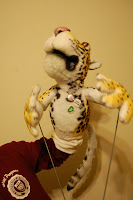Sadly to say, I've only recently come to appreciate concept art as its own form. It tends to be beautiful in its own way--especially color and light studies. Concept art evokes feeling in a way that the final product never does. I wonder why more films aren't made with a heavier emphasis on the dramatic looks of concept art.
One of my favorite films from the past few years is
Finding Nemo. I remember when I first saw
a teaser for it from the
Monsters, Inc. DVD--I was sold on the idea from the beginning. The movie has such a strong quality to it: a father learning to deal with his fear of loss, a son realizing the value of his dad, an unexpected journey. What I never realized was how intentional the different moods of the film were. Thinking about it, it is now very obvious, but at the time, it accomplished exactly what it should have: people had the feelings evoked without really knowing it. The beginning of the film is set in warm, light blues for a feeling of safety and security in the reef. As the journey begins, deeper blues set in--symbolizing both distance from home and greater danger. The dark blues of the shark's hideaway and the deep-sea moment are frightening. Then, suddenly, the medium blues of the open ocean don't seem quite as bad anymore. The jellyfish are an inviting--almost dreamy--pink and purple, though the bright red of Dory's wound from them serves as a stark contrast to their seeming safety. Finally, in Sydney Harbor, the dull greens and muckier water show despair: Marlin thinking Nemo is dead and Dory not knowing where she is or what she's doing. Below is an image from
Greg Hull, one of the concept artists for the film.

Other films in general (and Pixar films in particular) spend a lot of time getting colors and moods right. A character's environment plays a huge role in an audience interpretation of a scene. A laugh on a sunny day in a park seems light and innocent. Move that laugh to a dark, dank room, and it's either evil or nervousness.
I found a website today which has an OK collection of Pixar concept art. I would recommend the various "Art of" books, particularly from
Finding Nemo,
Cars, and
Ratatouille. I would say
Monsters, Inc., but I don't have that book, and it costs around $150, since it's now out of print.
Additionally, for Disney concepts, their "Art of" books (I remember "
Art of the Lion King" being really good; also, "
The Tarzan Chronicles") and "
Before the Animation Begins."
Here are some great examples of the different styles of concept art:
Aladdin (Aladdin's hideaway)
 Ratatouille (Paris skyline)
Ratatouille (Paris skyline)
The Lion King (Simba's return to Pride Rock) Beauty and the Beast (early Beast sketch)
Beauty and the Beast (early Beast sketch) WALL-E (WALL-E and Eve)
WALL-E (WALL-E and Eve)











